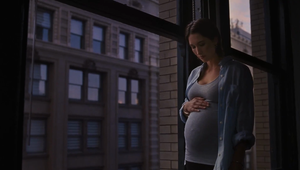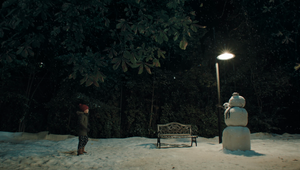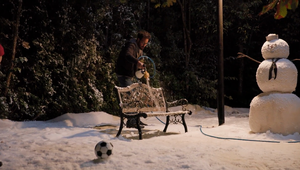Seasoned filmmaker. Tearjerker connoisseur. Storyteller extraordinaire. Sune Sorensen wears many hats, and he also just so happens to be the feather in Hey Baby’s cap. The production company welcomed the writer and director in 2019, after discovering that their creative values were well aligned: advocating for certain classic tropes associated with old school filmmaking, while remaining at the forefront of new, cutting-edge approaches to storytelling.
Best known for his heartwarming commercial output - he discourages labels like “sentimental” and “emotional” - Sune’s storytelling stands out in a world of flashy but flat, fast-paced but quickly-forgotten campaigns. Passionate about letting the story lead the way when it comes to the length of a commercial, the LA-based Danish director refuses to jeopardise the creative for the sake of a short and snappy 30 second spot.
Staying focused on the humanity of each creative brief - uninterested in surface-level short-termism - Sune is intent on eliciting emotive responses through organic engagement with content that resonates with audiences, cultivating brand loyalty that stands the test of time. The director gets candid with LBB’s April Summers, as talk turns to his initial approach to a new treatment, the role of sound and music, and his affinity for stories that strike a chord.
LBB> Why do you do what you do? What is it about your job that brings you the most joy?
Sune> It’s very simple, actually. If I can reach just one person with a story that touches them, or makes them laugh, or makes their day, that’s all I could ever wish for. I have been convinced of the power of storytelling since I started reading sci-fi novels as a kid and when I discovered the magic that is movies, I knew there was no turning back - I watched every movie under the sun and never stopped watching…
LBB> The style of a film changes brief by brief, but how would you underpin your general visual style? Are there certain factors that you could pinpoint as a signature for you?
Sune> I wouldn’t say it’s a style as much as it is an approach. I look at each story individually to find the key ingredients that will make it resonate with its target audience. However, those ingredients are defined by my taste, of course, which is essentially an expression of my personality. Ultimately, I think you will sense a love of cinema in most of my work and I’m not sure I would ever be able to, or even want to, hide that. I am story-centric and character-driven, sure, but first and foremost I am a fan of cinema. Consequently, I tend to view all projects in the light of a movie, with the same care and respect toward all of its elements; be it light, art direction, casting, or music.
LBB> How do you approach creating a treatment for a spot?
Sune> I put a lot of value into the first call with the agency, as this is when I am essentially trying to understand what their hopes and dreams are, what the client is looking for, and ultimately how I can contribute to making that happen. This way, when I’m writing the treatment, I have a very clear idea of what I want to do.
That said, I always allow the writing to guide me, especially to inspire new ideas or an approach that can elevate the result, which is also why I leave the script to the end. This way, I have a solid basis for the direction of the story and its characters. And speaking of, I think my natural instinct is to focus, first and foremost, on the story itself and its characters. What drives the story? How do I engage the audience from the very beginning and how do I ensure momentum, so we never lose their attention? What are the character motivations? Why do they do what they do? When those answers come to the surface, everything else is derived from there.
LBB> How significant is the role of sound and music? Is there a project which perfectly demonstrates how music influences storytelling?
Sune> In all honesty, it’s hard to think of a project where it doesn’t. Music and sound are absolutely paramount to the audience reception, but I find that it never works when it is forcing the emotions. I tend to view sound and music as a relationship, or a dance, in which both parties support and elevate each other. A great score can do that because it adapts so effortlessly to the storyline, but I do find that sometimes a great song can have the same qualities – I guess because even popular songs tell stories with the same inherent building blocks. Ultimately, I find that the right choice and balance of sounds and music can be the difference between good and great, but it only matters if the story and its characters are strong too.
I would say films like “Take Care” by DocMorris, or “Brothers” by BMW, “A Moment” and “Ralphie” by McDonald’s, “Back Home” by Nivea, and “Look Beyond” by Nreal, are all heavily influenced by their use of sounds and music. In “Take Care” we used inspiration from several scores and songs, which I sort of patched together in the editing room, as a reference for my wonderfully talented composers, then we worked together to create an original piece from that. In “Brothers” I approached the band behind the very famous song, ‘Say Something’ by A Great Big World, because I felt it was a perfect match for the story and they agreed to let us use it because they felt the same.
This was also the case for Nivea, where the song - ‘Skinny Love’ by Birdy - was a very appropriate expression of the fragile and vulnerable situations portrayed in the story. The song used in “A Moment” was actually performed by the actor and singer-songwriter, Eve Polycarpou, who plays the busker – and this acts as a storytelling device for the final reveal. In “Ralphie”, we played around with a wide array of fun instruments to mirror the child-like character of the story and the carefree feel of the spot. In “Look Beyond” we open on sounds only - no music - to set an indie tone that establishes the premise and then, later, allowing the score to propel the story forward, like in a movie. So every story tends to depend on music and sounds in some way or another.
LBB> At what stage in the process do you decide on the music?
Sune> It’s an ongoing process for me. I will start listening to music the second I get the board and hear the idea. Sometimes the agency will have presented their own ideas for the music, which often inspires me in other ways too. I don’t like overly predefined music because it can lead to what feels like a forced experience: if we define the tone with a song before the scenes have fully developed, or before I even know who the actors are, I am limiting myself and the project too much. I try to keep things open until we are in the editing room and actually know what we have - and then we will usually try out a lot of different approaches. You could say that I audition music the same way I audition the cast – it has to feel like the right fit and benefit the story in a meaningful way.
LBB> Looking through your body of work, there is a clear focus on the human experience. How do you identify the humanity at the heart of a creative brief?
Sune> It is usually staring right at me the second I read the brief. Sometimes it needs a little nudge to bring it to the surface, while other times it needs a better balance to remain subtle and authentic. I think the humanity of a brief lies within many layers. Of course, you can find it in its characters or its message but, usually, it lies within the intentions behind the brief and in those who spent time creating the brief. Consequently, I will always test my assumptions in the first agency call to ensure I am on the right track and then, if I am, I will have propositions and ideas to execute and enhance it.
LBB> At what point in your career did you realise you have a natural affinity for this kind of sentimental storytelling?
Sune> I am not sure I love the term “sentimental”, or even “emotional storytelling”, which is another label often used for stories that touch an audience. I guess I find that any story should be able to evoke emotions with its target audience because if it doesn’t I’m not sure what the point would be. We need to care about the characters, the turning points, and the climax of a story.
In commercials, everyone loves to use labels so it’s easier to define something or someone, but the truth is I started out making mostly comedy. So you could say the defining moment, when the industry decided to define me as an “emotional storyteller” was when I did a short for VW, which won a lot of awards. After that, I mainly got those types of boards and I learned a lot from that. Firstly, I learned that when I write the stories - which I did with VW - or when I am allowed creative room to craft a more complex story - which was the case with Nivea, McDonald’s, Nreal, BMW - it tends to fare better. Secondly, I learned that every great story needs to be dynamic and I think that’s why I had success with these types of stories, because they are more complete in the sense that they contain everything – not just one concept, idea, or emotion. “Take Care” or “Nivea” have several moments of levity, humour, and warmth, because if they didn’t we wouldn’t care, which is what it essentially boils down to. If I care about the story, the audience will too, and I tend to care about stories with heart or a more profound message.
LBB> What do you think it is about a heartstring tugging emotional connection with an audience that is advantageous for a brand?
Sune> I think the answer to that lies in the question. If you can establish an emotional connection with a target audience, you are creating a long lasting bond with a consumer and ultimately creating a brand preference. But don’t take my word for it, look at any successful brand. Even product-centric brands like, say, Apple, are doing some of the best branding out there. Evoking an emotional connection with an audience will establish a strong connection to your brand and in the long run, this will translate to wins. If you can make someone smile, laugh, or cry - perhaps even share your commercial as content - then you have something special. “Take Care” and “Look Beyond” are good examples of that: both went viral, both successfully established brands in the hearts of the consumers and both have been reaping the benefits ever since.
LBB> What do you prefer about working on spots with longer running times?
Sune> I don’t mind doing 30’ or 45’ spots and I have done a lot, but I would be hard pressed to find any examples that manage to touch me or stay memorable. There are examples but they are very rare and usually based on at least a 60’ hero film. But let’s be honest, why is there even a 30 or 45 seconds format? It was defined by the limitations and price of a TVC. Nowadays, a lot of campaigns run online and we don’t have those limitations: in fact, several agencies I have worked with insist that branding films should be exclusively launched online and all efforts around the campaign should guide the audience towards the hero film – because it works.
Ultimately, I think a story should take the time it needs to be told. Some movies can be told in 90 minutes, some need over 120 minutes, and before you say no, think “Pulp Fiction”, “Shawshank Redemption”, “Raging Bull”, “Fight Club”, “A Clockwork Orange”, I can keep going... However, I don’t know a lot of great movies that are 70 or 80 minutes long, and I think the same goes for commercials. There is a certain minimum requirement for a story to touch you and I personally believe it lies around the 60 second mark (for online content, it could be 68 seconds or 54 seconds), and sometimes it requires 120 seconds or 180 seconds. In fact, I did an eleven minute short film for a brand, and some were a little concerned about whether the audience would watch it, but people watch hours upon hours of random videos online every day and if a story engages them, they will watch it. In the end, that short film was a huge success, reaching half the nation.
LBB> What do you think brands are missing when they opt for the short, punchy 30 or 60 second spots?
Sune> I think 30 and 60 second spots can work but it truly depends on the concept and the idea. I find that the focus (or perhaps obsession) with length to be a rather unhelpful preoccupation. It’s a huge misconception that audiences these days have a short attention span and we should make content short and snappy in fear of viewers immediately clicking off, scrolling away or skipping something. If you think about how much time we spend watching YouTube videos about subjects that interest us – time doesn’t come into it. The truth is that audiences will skip anything that isn’t interesting and they will watch anything that is. If brands want to reach their target audience, they should be more concerned about crafting great stories and content, than the runtime. I have watched mind-numbingly boring and hyper-pumped-albeit-still-generic 30 second spots, and I’ve seen riveting and engaging five minute content. You could say that if your content isn’t worth two or three minutes of someone’s time, you’re doing it wrong - and usually the “it” is that it looks like a commercial.

















